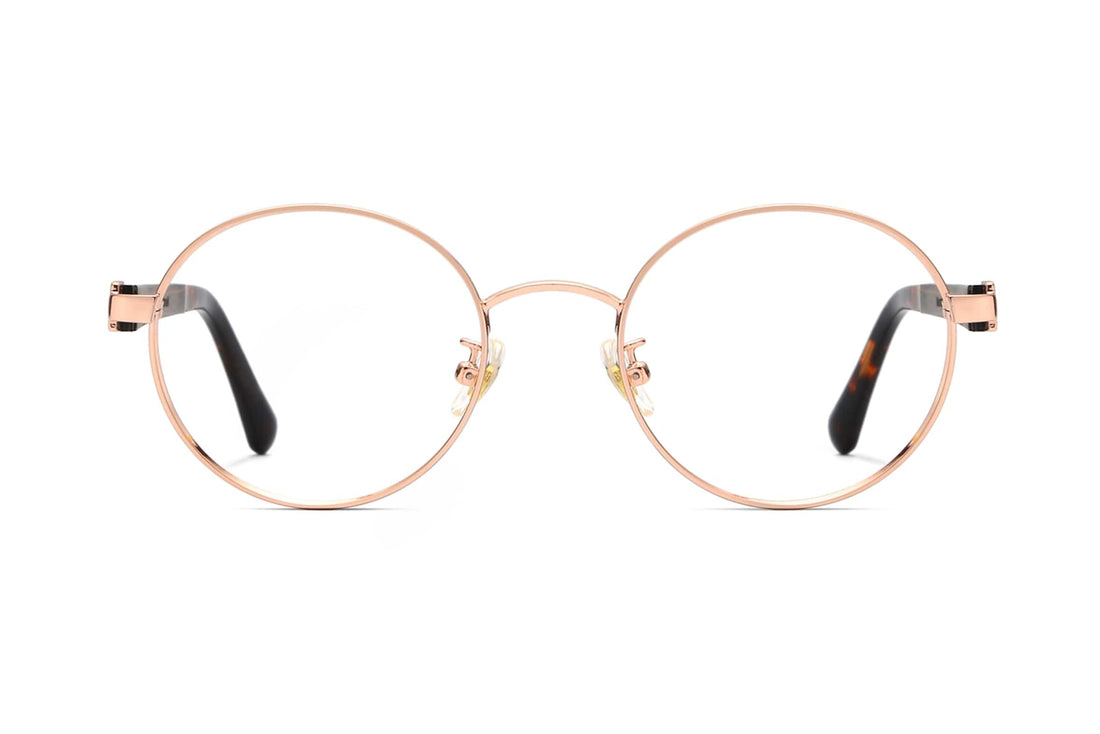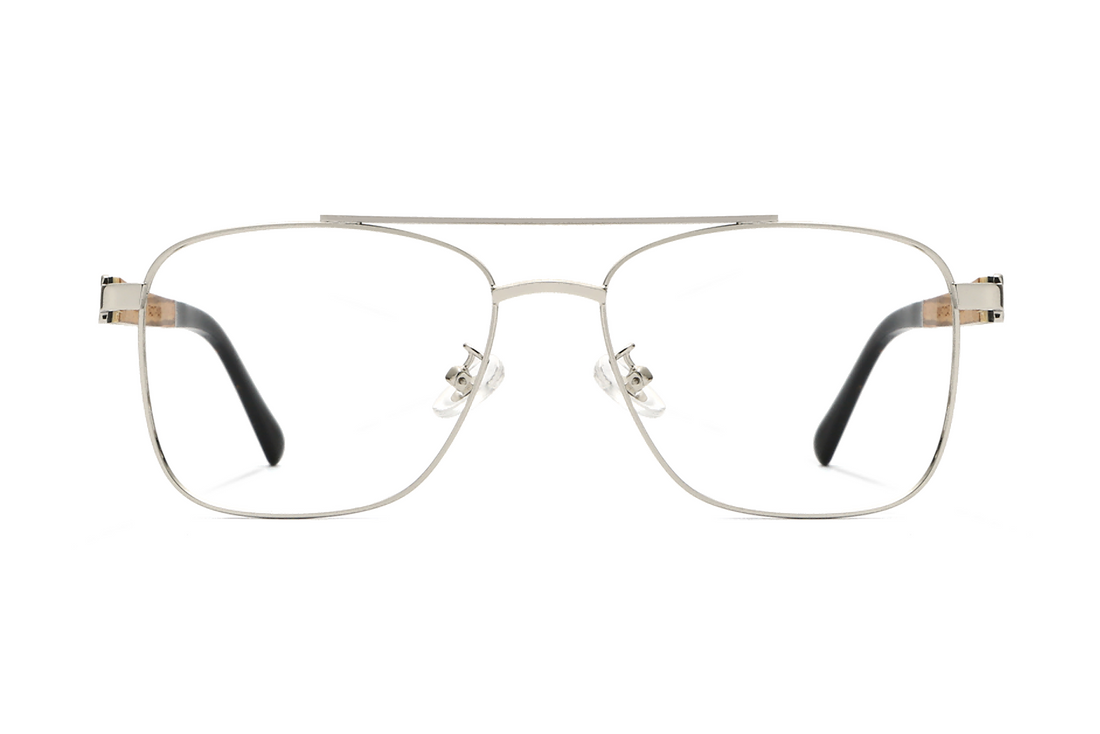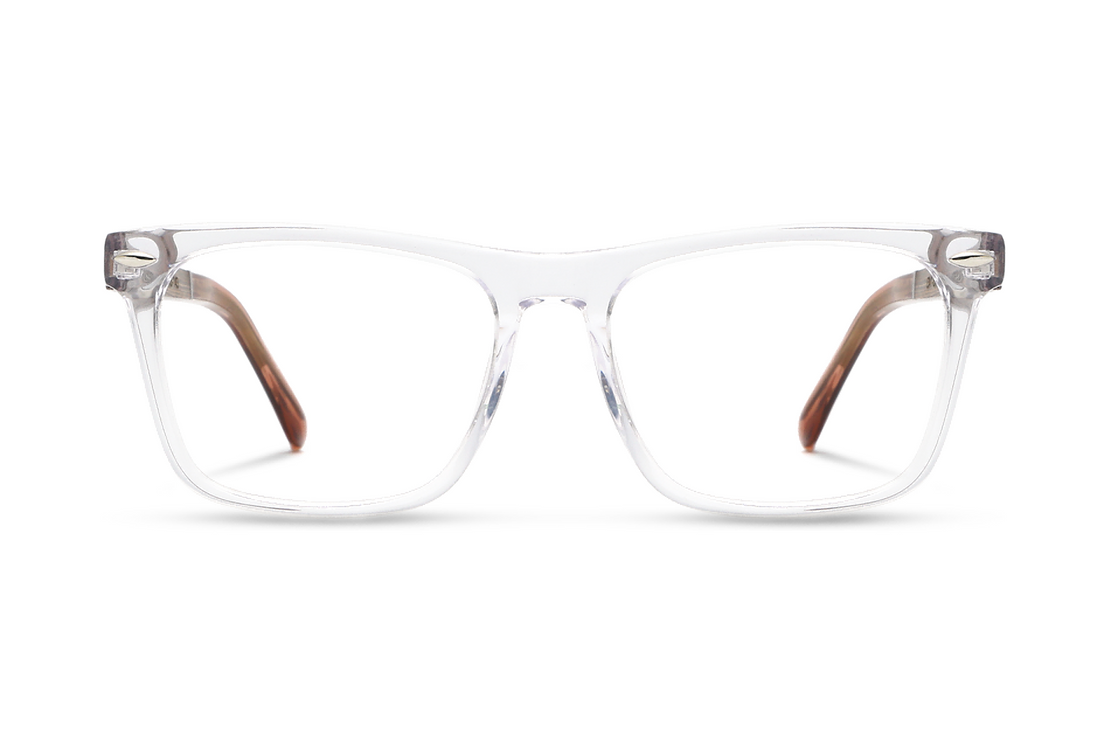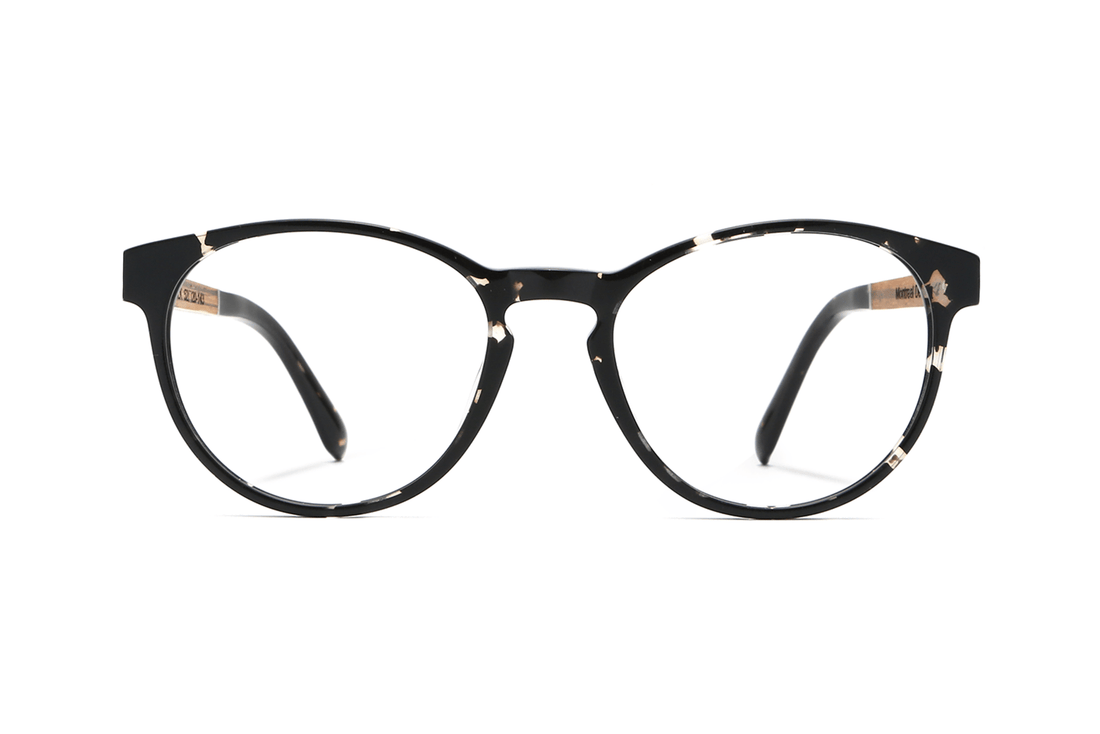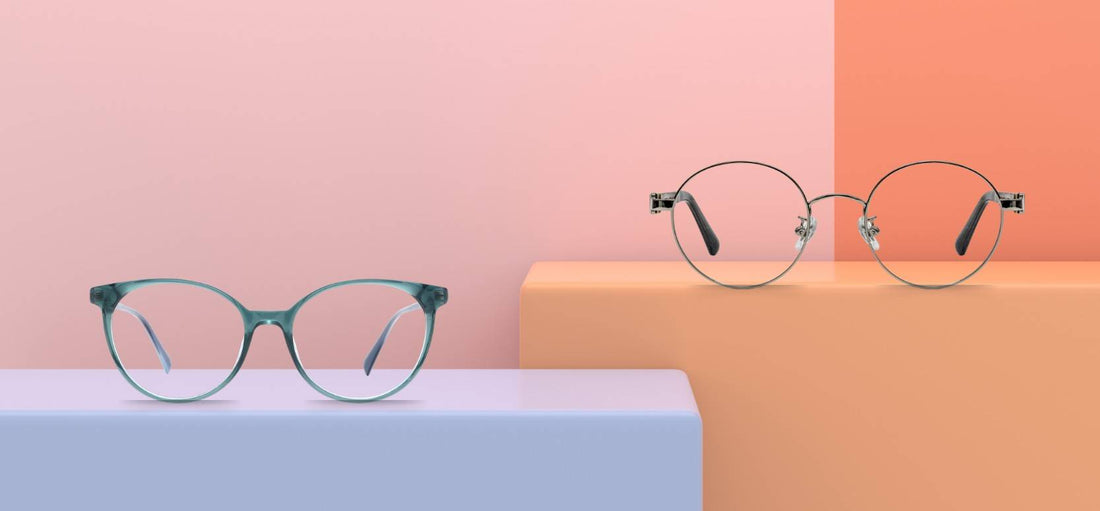
Acetate vs Metal Frames: How to Choose Your Perfect Eyewear
Acetate vs Metal Frames
7 min read • Posted on 15 March 2024
Consumers often encounter a debate about acetate glasses and metal glasses frames when selecting the proper eyewear. Each material has advantages, influencing your look and how you experience the world through your glasses. This post will delve into the unique properties of acetate vs metal frames, helping you complete an educated judgment that aligns with your style and lifestyle needs.
Acetate, a plant-based plastic, is renowned for its rich colors and flexibility, while metal frames are celebrated for their durability and classic elegance. But there’s more to each material than meets the eye. As we compare acetate vs metal frames, we’ll explore how these differences impact everything from comfort to maintenance, ensuring you choose frames that look great and stand the test of time.
Metal Eyewear Frames
A Metal eyewear Frame is a type of glass made from various metals and plastic materials such as titanium, stainless steel, aluminum, or an alloy like Monel. These plastic eyeglass frames are known for their durability, flexibility, and sleek, classic look.
The process of making metal eyewear frames typically involves several steps:
-
Design: The frame’s design is created considering aesthetics, functionality, and comfort.
-
Material Selection: A suitable metal or metal alloy is chosen based on properties like strength, weight, and hypoallergenic qualities.
-
Cutting and Shaping: The metal is cut into thin sheets or wires and then shaped into frame components using precision tools.
-
Welding or Soldering: The components are welded or soldered together to form the basic shape of the frame.
-
Plating and Coloring: Frames are often plated with a delicate coating of another metal (nickel or palladium) to enhance corrosion resistance and appearance. They may also be colored through various processes.
-
Polishing: The frames are polished to create a smooth, finished surface.
-
Assembly: Finally, all the parts, including hinges and screws, are assembled to complete the frame.
Metal frames are appreciated for their sophisticated, minimalist look and the ability to withstand the rigors of daily use, making them a popular choice for eyeglass wearers.
Top 7 Features and Benefits of Metal Eyewear Frames
Here are the top 7 features and benefits of metal eyewear frames, each explained in detail:
-
Solid and Durable: Metal frames are known for their strength and durability. They can resist everyday wear and tear, making them a durable and long-lasting choice for eyewear.
-
Lightweight and Comfortable: Despite their strength, metal frames are often lightweight, contributing to their comfort. You can sport them for comprehensive periods without feeling weighed down or experiencing discomfort.
-
Hypoallergenic: Many metal glasses frames are made from hypoallergenic materials like titanium and stainless steel. This makes one of these materials an excellent option for people with sensitive skin or allergies.
-
Invulnerable to Corrosion: Metals such as stainless steel and titanium are corrosion-resistant, so your frames won’t quickly tarnish or degrade when exposed to sweat or moisture.
-
Resistant to Temperature Changes: Metal frames are less likely to be affected by temperature changes. This means they won’t become brittle in the cold or overly flexible in the heat, maintaining their shape and integrity.
-
Flexibility: Metal frames, especially titanium frames made from materials like metal alloy, can offer flexibility. This flexibility allows the frames to bend under pressure and return to their original shape, reducing the risk of damage.
-
Style and Elegance: Metal frames provide a classic, elegant look that never goes out of style. They come in various styles, colors, and finishes, permitting you to choose a pair that complements your style and adds sophistication to your appearance.
These features make metal eyewear frames a versatile and practical choice for anyone looking for reliable and stylish glasses.
Top metal materials used in eyeglass frames
The top metal materials used in eyeglasses and spectacle frames are known for their unique properties that cater to different needs and preferences. Here’s a detailed look at some of the most commonly used metals in spectacle frames:
Monel: It's the most widely used metal in eyeglass frames. It’s an alloy that can contain many other metals, but typically, one frame includes nickel and copper. Monel is malleable, corrosion-resistant, and cost-effective. However, it may cause skin irritation for those with nickel allergies unless it’s plated with a hypoallergenic material.
Titanium: Renowned for its strength, lightness, and corrosion resistance, titanium is also hypoallergenic, making it ideal for people with sensitive skin. It’s a premium material that’s also flexible, extremely durable, and available in various colors.
Stainless Steel: This is another famous frame option due to its durability, lightness, and resistance to corrosion. Stainless steel frames are also less likely to cause allergic reactions and are often more affordable than titanium alloy front frames.
Aluminum: Comprehended for its weightless and corrosion-resistant properties, aluminum offers a unique look and is often used in high-end eyewear designs. It’s also strong and flexible.
Beryllium: This is a lower-cost option to titanium that’s lightweight, strong, and flexible. Beryllium resists corrosion and tarnishing, making it suitable for people with high skin acidity or those living in coastal areas.
Flexon is a titanium-based alloy known for its remarkable flexibility. Frames made from Flexon can return to their original shape even after bending. This material is lightweight, extremely durable, and hypoallergenic.
Beta Titanium: This is an alloy of pure titanium, which includes a small amount of vanadium and aluminum, making it more flexible than pure titanium. Beta titanium is used in eyeglass frames and plastic materials that require thin, lightweight, and flexible characteristics.
These different metals and materials are chosen for eyeglass frames based on their properties, such as weight, strength, flexibility, corrosion resistance, and hypoallergenic potential, to provide a comfortable and durable option for eyewear.
Acetate Eyewear Frames
An acetate eyewear plastic frame is a type of glass made from cellulose acetate, a plant-based plastic emanating from genuine originals like wood pulp and cotton fibers. Due to its renewable origins, this material is known for being lightweight, hypoallergenic, and environmentally friendly.
The manufacturing process of acetate frames typically involves the following:
-
Creating the Acetate Material: Cellulose acetate is produced by treating cotton fibers and wood pulp with acetic acid. The resulting material is formed into sheets.
-
Coloring: The acetate sheets are infused with dyes to create various colors and patterns. Unlike other plastics, the color in acetate is embedded throughout the material, not just on the surface.
-
Cutting and Molding: The colored acetate sheets are cut into the desired frame shapes. They are then molded using heat to form the final frame design.
-
Polishing: After molding, the frames are polished to a smooth finish, enhancing their appearance and comfort.
-
Assembly: The final step involves assembling the frame with hinges, screws, and other necessary components to prepare them for lenses.
Acetate frames are famous for their durability, flexibility, and the rich, deep colors they can achieve, making them a stylish choice for eyewear.
Top 7 Features and Benefits of Acetate Eyewear Frames
Here are the top 7 features and benefits of acetate eyewear frames, each explained in detail:
-
Hypoallergenic: Acetate is a non-irritating material, making it ideal for wearers with susceptible skin. It decreases the chance of allergic responses and skin irritation.
-
Lightweight: Frames made from acetate are lightweight, providing a comfortable fit. This can reduce the pressure on the nose and ears, making them suitable for long-term wear.
-
Durability: Acetate frames are comprehended for their durability. They withstand wear and tear and maintain their shape and appearance over time.
-
Flexibility: Acetate has a degree of flexibility, which allows for a more comfortable fit. This flexibility also makes the frames less likely to break.
-
Rich Colors and Patterns: The material allows for a broad scope of colors and designs, which are embedded into the frame, not just painted on, leading to a more vibrant and lasting finish.
-
Adjustability: Acetate frames can be quickly heated and molded, allowing opticians to adjust the fit for individual wearers and ensure a perfect fit.
-
Eco-Friendly: As a plant-based plastic, acetate is more environmentally friendly than traditional petroleum-based plastics, making it a sustainable choice.
These features make acetate eyewear frames a versatile and stylish option for those seeking high-quality plastic and comfort in their next pair of glasses.
Are plastic eyewear frames similar to Acetate eyewear Frames?
Plastic eyewear frames and acetate eyewear frames are similar in that they are both used to make glasses, but there are several key differences between the two different materials:
Material Origin: Acetate is derived from plant-based materials like wood pulp and cotton fibers, making it a renewable resource. Regular plastic frames are typically made from petroleum-based nylon pellets.
Hypoallergenic Properties: Acetate is known for being hypoallergenic, which is beneficial for wearers with sensitive skin. Plastic frames may not offer the same hypoallergenic qualities.
Weight and Comfort: Acetate frames are generally lightweight and comfortable to wear, whereas plastic frames can be heavier and less flexible, which might affect comfort levels.
Adjustability: Acetate frames can be easily adjusted for a better fit by heating and molding them, while plastic frames are more rigid and challenging to change.
Durability: Acetate is known for its durability and capability to maintain its form and color over time. Plastic frames can be more brittle memory metal and prone to breaking.
Color and Pattern: The color and pattern in acetate frames are embedded within the material, offering a richer and more lasting finish. Plastic frames often have colors painted or sprayed on, which may fade or chip over time.
Environmental Impact: Acetate is considered more eco-friendly due to its plant-based origin, whereas regular plastic has a more significant environmental impact because it is derived from fossil fuels.
These differences highlight that while both materials serve the same function, they offer distinct features and benefits that might make one more suitable depending on the wearer’s needs and preferences.
The top 5 differences between metal and acetate eyewear frames are:
Material Composition: Metal frames are typically made from materials like titanium, stainless steel, or aluminum, which offer durability and a sleek look. Acetate frames are made from plastic derived from plant-based materials, providing a lightweight and often more colorful option.
Adjustability: Metal frames often come with adjustable nose pads that can be tailored for a custom fit, while acetate frames usually have a fixed bridge that may not offer the same adjustability.
Allergenic Properties: Metal frames can contain nickel, which some people are allergic to. Acetate, a hypoallergenic material, is less likely to have nickel-free cause allergic reactions.
Durability and Flexibility: While both metal frame materials are durable, the metal frame can be more prone to bending and requires careful handling to maintain shape. Acetate frames are generally more flexible and can retain their shape better over time.
Style and Design: Acetate frames allow for a broader range of colors and patterns, as the color is embedded within the frame material itself. Metal frames tend to have a more classic and timeless design, often in muted tones.
These differences help you decide which type of frame suits your needs and preferences.
Metal eyewear frames vs. Acetate eyewear frames: which eyewear frame is better?
The choice between the metal and plastic frame and acetate eyewear frames isn’t about which is universally better but better suited to your needs, preferences, and lifestyle. Here are some considerations to help you decide:
-
Comfort: Lightweight materials like certain metals or acetate might be preferable for extended wear.
-
Durability: Metal frames can be very durable but may require careful handling. Acetate is also durable and retains its shape well.
-
Style: Acetate offers many colors and patterns, while metal frames often have a classic, timeless look.
-
Hypoallergenic Needs: Hypoallergenic options like titanium or acetate would be vital for sensitive skin.
-
Adjustability: Metal frames with nose pads offer more adjustability, while acetate frames are usually fixed but can be heat-adjusted by an optician for fit.
-
Maintenance: Consider the relief of upkeep and repair, as metal frames may sometimes need more attention than acetate.
-
Cost: Budget can also be a factor, as the price range for different types of metal and acetate frames can vary widely.
Ultimately, it is about balancing these factors with what feels suitable for you. Try on different frames and consult with an optician to find the best fit for your face shape, skin tone, and lifestyle.
Conclusion
The choice between an acetate frame and a metal frame ultimately boils down to individual tastes and specific needs. Whether you prioritize hypoallergenic materials, need a lightweight option for all-day wear, or desire a particular aesthetic, there’s a frame material out there that’s perfect for you. We hope this guide has shed light on the nuances of an acetate frame vs metal frames, empowering you to select eyewear that complements your vision and enhances your style.
Remember, the best way to determine which frames suit you best is to try them on and see how they feel. Don’t hesitate to visit your local optician to experience the difference between acetate and metal frames firsthand. With the proper knowledge and a little experimentation, you’ll find the perfect pair of glasses you’ll love to wear daily.
 Heba Ahmed
Heba Ahmed



























